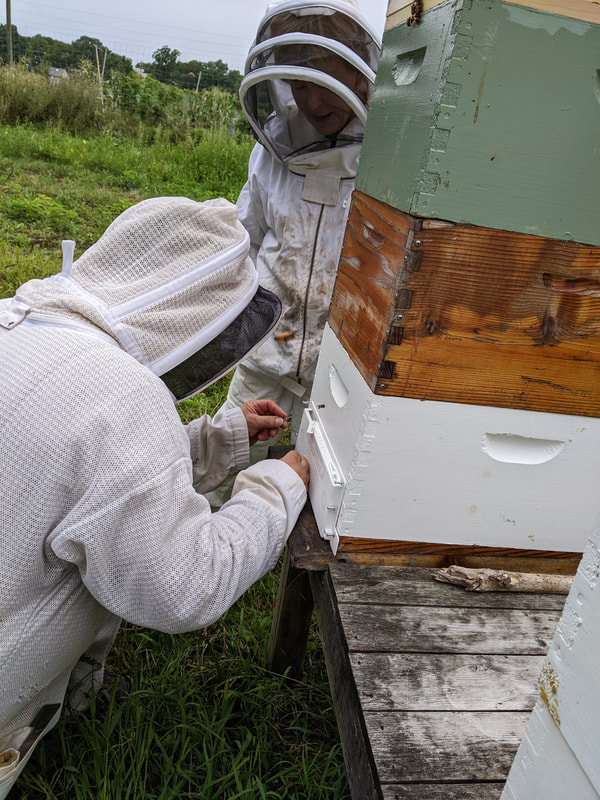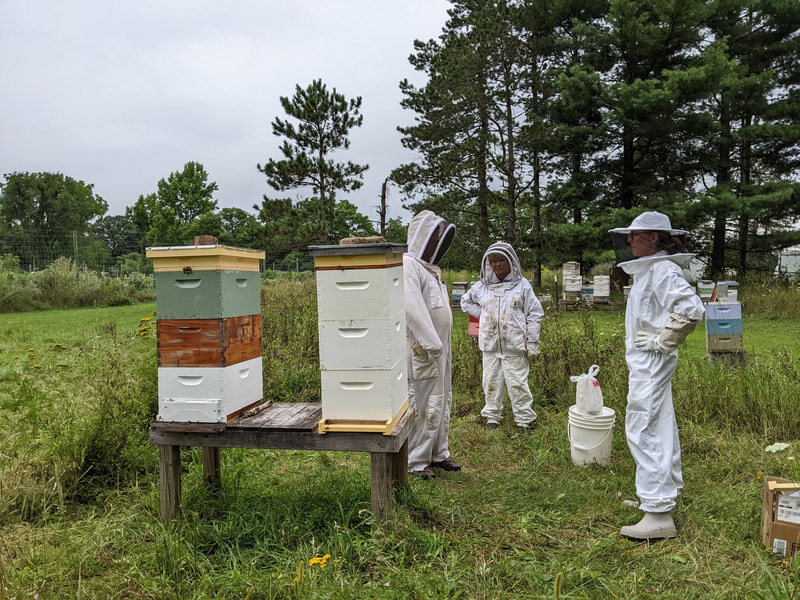|
I'm happy to report that despite the new, two-gallon, top feeders being full about 3 days after we put them on, today they were empty and all that syrup has been converted to wax on the new foundation frames! Huzzah! Also, we performed alcohol washes on both hives and found a <1% infestation of Varroa on both mite checks (reported proudly to the BIP Mite-A-Thon). We also were lucky enough to spot both queens (easier now that they're both marked). We did see one small hive beetle (which Clay squished), but most hives have a few running around and they aren't typically a problem in strong hives. We filled the feeders back up and are now in great shape for winter! Our next check will be: Saturday, September 24th, 2022 at ***11am*** in the A2B2 teaching apiary in the Campus Farms area of Matthaei Botanical Gardens. [PLEASE NOTE LATER START TIME!!!] Plan: 1. Checking top feeders to see if bees are taking syrup. 2. Check frames to make sure all drawn comb and filled with honey. 3. Mite test (alcohol wash) to make sure we have strong bees going into winter 4. If mite counts are above threshold, treat with FormicPro strips. If you would like to join the A2B2 Flow Hive Team or would like to know more about the Flow Hive in general, please contact Jen Haeger at [email protected].
0 Comments
At this Flow Hive Check, we wanted to check to see that the introduced queen of the split hive was laying well, find her and mark her with a yellow dot (for 2022), add a third deep box to the split, apply robbing screens to the entrances of both hives, and add 2-gallon top feeders of sugar syrup to get the bees to draw out wax on foundation frames in the hives. I'm glad to report success on all fronts except that we only applied one robbing screen to the original hive and left in the entrance reducer of the split hive. Everything is looking great as we fatten up the hives and prepare for winter. Our next check will be: Saturday, August 27th, 2022 at 10am in the A2B2 teaching apiary in the Campus Farms area of Matthaei Botanical Gardens. Plan: 1. Checking top feeders to see if bees are taking syrup. 2. Check frames to see if bees have been drawing out comb. 3. Mite test (alcohol wash) to make sure we have strong bees going into winter and report to the BIP August Mite-a-Thon! (https://beeinformed.org/2022/05/06/join-the-2022-mite-a-thon/) 4. If mite counts are above threshold, we will have to wait until the weather will be below 85 degrees Fahrenheit for 3 days (Wednesday) to treat with FormicPro strips. If you would like to join the A2B2 Flow Hive Team or would like to know more about the Flow Hive in general, please contact Jen Haeger at [email protected]. Just when I thought harvesting honey was a lot of work, try going through 4 deep boxes to find the queen on a blistering hot day only to have to go through 2 of the boxes twice! That's 48 frames we painstakingly examined before we found her majesty which is pretty funny since every other time we've been in this hive we've found her right away, even when we weren't looking for her! But, in the end, we did find and mark our old queen (white dot for 2021 enclosure) who is starting to slow down just a little in egg production. Whilst we were searching for the queen, we did a thorough inspection and assessment of each and every frame in the hive so we could most evenly divide resources between the old hive and the new hive (for a breakdown of what was on each frame, please scroll to the end of the post). Yes, we took our big, booming honey factory and split it into 2 hives to prepare for placing our new Flow Super on a second hive next year! One technique that we used to great effect was separating the 4 boxes while we did the inspection so that 3 of the boxes would sense the absence of the queen and those bees would be more willing to accept the new mated queen we snagged from the A2B2 Queen-rearing program. Thank you to Paul Mazur for bringing her to me! So, after we found and marked old "Flo" white, we took a sample of 10 larvae to send to MSU for a European Foulbrood surveillance study. Then we did a quick alcohol wash to see if our previous treatment with Formic Pro strips and our Integrated Pest Management drone board technique are keeping our mite levels down. We were happy to see only 1 mite/300 bees! So things are looking great on the Varroa front. Finally, we distributed the frames so that both hives had equal amounts of brood, pollen, honey, and drawn comb and made two hives, one with 3 boxes and the old queen, and one with 2 boxes and the new caged queen. We left her in a queen cage plugged with marshmallow, and were optimistic that she would be accepted because the bees that covered the cage were easily brushed off and were more happily interested in her than angrily trying to murder her through the cage. Two days later we checked the cage and found it empty and the bees acting content, so it looks like a successful introduction. Plan for Next Check: 1. Make sure new queen is laying well. 2. Mark new queen with yellow dot (2022). 3. Add a 3rd box to the new hive with 4 frames of new wax foundation and 4 frames of drawn comb from the old hive. 4. Feed both hives 1:1 sugar syrup to encourage them to draw out the foundation frames before winter. 5. Place robbing screens on box hives. The next Flow Hive check will be on Sunday, August 14th, 2022 at 10am at the A2B2 Teaching Apiary next to the Project Grow Garden in the Campus Farm area of Matthaei Botanical Gardens. Hope you can bee there! If you would like to join the A2B2 Flow Hive Team or would like to know more about the Flow Hive in general, please contact Jen Haeger at [email protected]. Frame Inventory:
Green Box = #1 - lots of back-filling of the brood chamber with honey 1. little pollen, mostly capped honey 2. honey, pollen 3. pollen, nectar, honey (moved to box 5 = wet box, deep white on bottom of old hive and replaced with wet honey frame from box 5) 4. same as 3 (moved to box 4 and replaced with wet frame from box 5) 5. same as 3 (moved to box 5 and replaced with frame of nectar where some of the frame still needs to be drawn out from box 4) 6. same as 3 7. same as 3, but slightly more capped honey 8. mostly capped honey Flow Hive Brood Box - Tan = #2 1. honey - 80% capped on one side & 20% capped on the other side 2. capped honey, nectar, pollen (moved to box 5) 3. capped brood, honey, pollen, eggs, open brood, drones present 4. eggs, drones, capped brood, open brood 5. capped & open brood, no eggs, pollen 6. eggs, open & capped brood 7. honey, pollen 8. capped honey - 100% White Box = #3 1. 100% capped honey 2. 100% capped honey one side, 70% on other side 3. bare foundation - starting to be drawn out with wax 4. same as 3 (moved to box 5 and replaced with wet frame from box 5) 5. capped brood 6. capped & open brood 7. black plastic foundation - starting to be drawn out with wax 8. 100% capped honey White Box = #4 1. nectar, drawing out plastic foundation (moved to box 5 and replaced with wet frame from box 5) 2. only partially drawn, some nectar - looks like bees ate off wax coating (moved to box 1 and replaced with pollen frame from box 1) 3. almost 100% capped brood, dark comb 4. drawn comb and nectar (moved to box 5 and replaced with pollen frame from box 1) 5. capped brood, but still some wax being drawn 6. nectar, drawing out wax (moved to position 7 and replaced position 6 with wet frame from box 5) 7. barely drawn out comb (moved to box 5?) 8. 100% capped honey White Box = #5 (box of extracted honey frames after all the swapping) 1. nectar 2. pollen 3. wet 4. bare foundation 5. wet 6. bare foundation 7. pollen 8. honey Current Hives: Original White Box = D1 1. nectar 2. pollen 3. wet 4. bare foundation 5. wet 6. bare foundation 7. pollen 8. honey Flow Hive Brood Box - Tan = D2 1. honey - 80% capped on one side & 20% capped on the other side 2. wet honey frame? 3. capped brood, honey, pollen, eggs, open brood, drones present 4. eggs, drones, capped brood, open brood 5. capped & open brood, no eggs, pollen 6. eggs, open & capped brood 7. honey, pollen 8. capped honey - 100% Green Box = D3 1. little pollen, mostly capped honey 2. honey, pollen 3. wet honey frame 4. wet honey frame 5. nectar where some of the frame still needs to be drawn out 6. pollen, nectar, honey 7. same as 6, but slightly more capped honey 8. mostly capped honey New - the new hive was put together while the mite check was going on, so may not be the correct box or frame order White Box = D1? 1. 100% capped honey 2. 100% capped honey one side, 70% on other side 3. bare foundation - starting to be drawn out with wax 4. wet honey frame 5. capped brood 6. capped & open brood 7. black plastic foundation - starting to be drawn out with wax 8. 100% capped honey White Box = D2? 1. wet honey frame 2. pollen 3. almost 100% capped brood, dark comb 4. pollen 5. capped brood, but still some wax being drawn 6. wet honey frame 7. barely drawn out comb? 8. 100% capped honey |
What is a Flow Hive?
A Flow Hive is a Langstroth-style hive system with plastic frames which allow honey to be harvested directly from the hive. www.honeyflow.com/pages/how-flow-works Archives
May 2024
Categories |









 RSS Feed
RSS Feed
